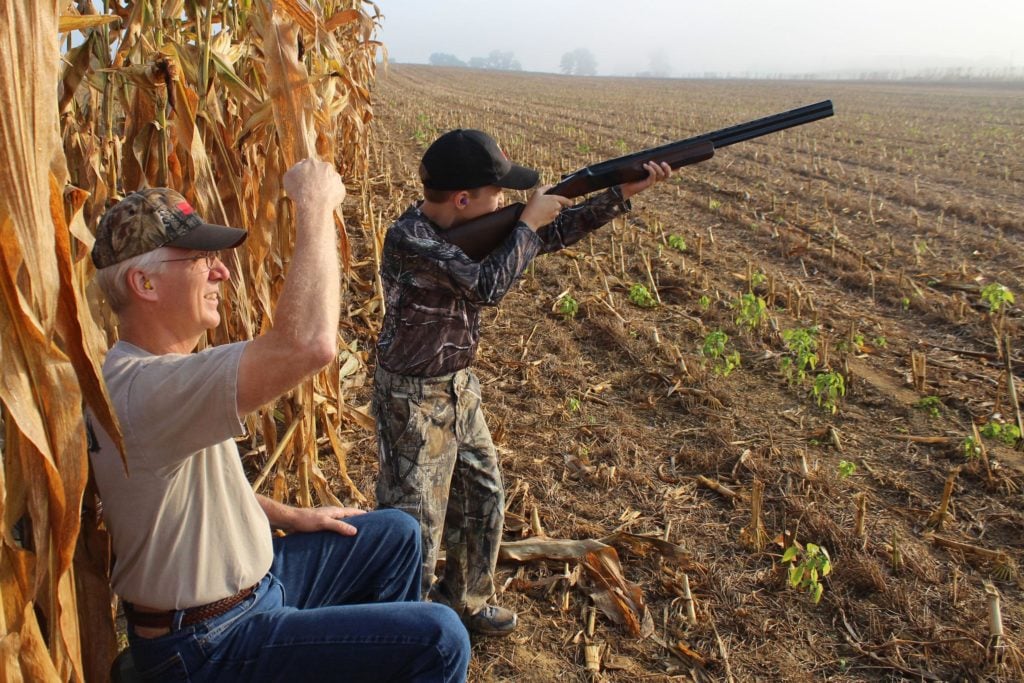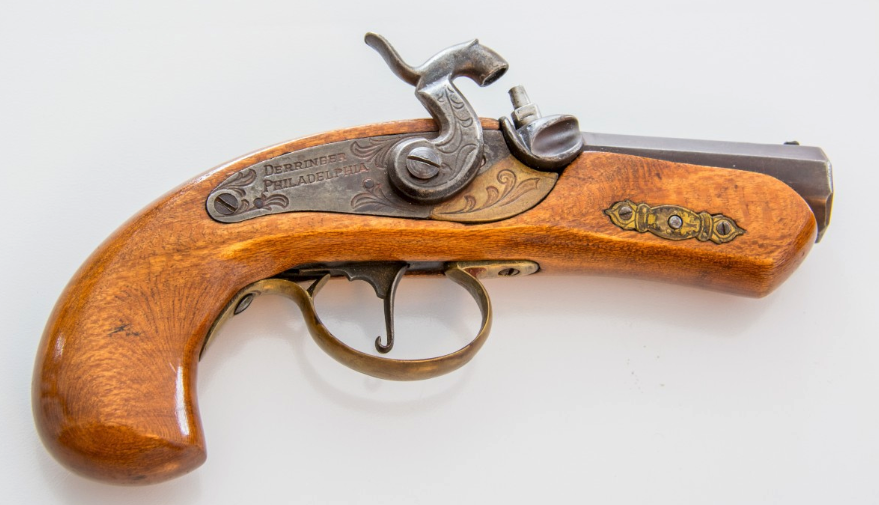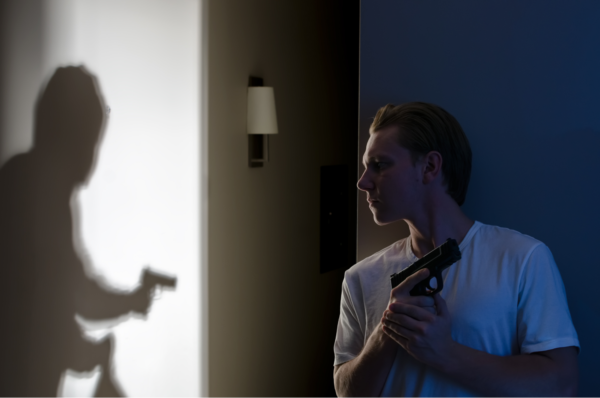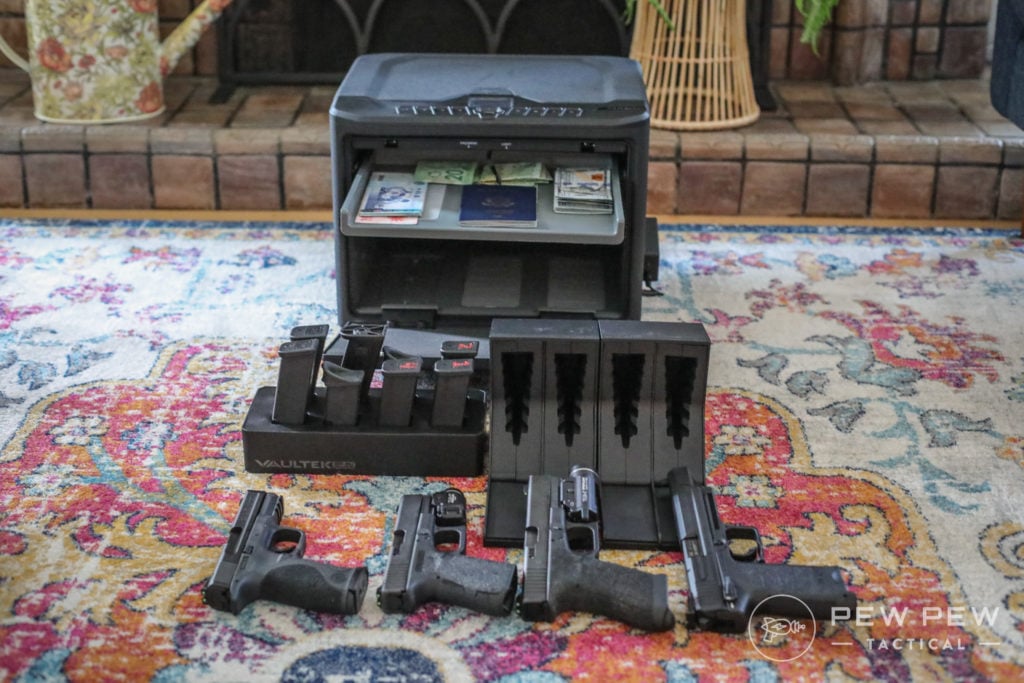Last Updated: May 9, 2021
Disclaimer: While the information provided here is legal in nature, it is not to be construed as legal advice, and is for educational and entertainment purposes only.
Keeping up with the latest gun laws of your state has become more important than ever in making sure you are on the right side of the law when it comes to owning and using your firearms.
While South Dakota has relatively gun-friendly laws on the books, there are still a few laws you’ll have to keep in mind when purchasing firearms.
We’ll go over everything you need to know on how to buy a gun, and where and when you can use it!

Buying a Handgun in South Dakota
Actually getting a handgun isn’t too big of a hassle in South Dakota, though there are some basic requirements that you’ll have to meet.
To buy a handgun, you must:
- Be 21 or older;
- Provide state ID; and
- Have a background check performed by a licensed firearms dealer.
Those that have a South Dakota concealed carry permit can actually just present their permit to skip the background check portion of the buying process.
Beyond those requirements, however, there is an additional application that has to be filled out when buying a handgun from a federally licensed firearms dealer (FFL). This application has to be filled out every time you want to buy a firearm, but only if you don’t have a carry permit.
Of course, for those of you paying close attention, you’ll notice the application is only for buying from an FFL. If you decide to buy a handgun through a private sale, then you don’t have to worry about the application, and you can also skip the background check as well! Talk about a twofer!
However, we’re not done yet! There are situations where you are prohibited from owning a firearm, even if you meet all the other requirements above.
You cannot own a firearm if you:
- Have been convicted of a crime punishable by imprisonment for over a year;
- Are a fugitive from justice;
- Illegally abuse controlled substances;
- Have been adjudicated as mentally defective of incompetent, or have been committed to a mental institution;
- Are an illegal alien;
- Are a former US citizen who has renounced his citizenship;
- Were dishonorably discharged from the US Armed Forces;
- Are subject to a restraining order; or
- Were convicted of a misdemeanor crime of domestic violence.
What About the Children???
If you’re under 21, you won’t be able to buy a handgun. But South Dakota has you covered! If you are 18 or older, you can own a handgun, if you purchase through a private seller.
Even better though, if you are under 18 and can’t buy a pistol yet, there are still situations where you can have and use a handgun anyway.
A person under 18 can use a pistol, with the consent of his parent or guardian, and the person is:
- In the presence of the parent or guardian;
- On property owned or leased by him, his parent, guardian, or immediate family member;
- In the presence of a licensed or accredited gun safety instructor; or
- Using the pistol for farming, ranching, trapping, target shooting, or in a gun safety course.

Don’t forget about long guns!
As nice as that shiny new 1911 is, you shouldn’t ignore the AR-15s and shotguns sitting on the shelf of your local gun store either!
To buy a long gun, you must:
- Be 18 or older;
- Provide ID; and
- Have a background check performed by a licensed firearms dealer.
Just like with handguns, a CCW permit will let you avoid the background check. Unlike the process of buying a handgun, you do not have to fill out any applications to buy a long gun, regardless of whether you are purchasing from an FFL or a guy you met on Craigslist (you’re meeting him at the police station parking lot though, right?).
If you do decide to buy a long gun through a private sale, you can still avoid the background check just like with a handgun, though.
For our antique-collecting friends…
If you are interested in purchasing antique firearms, there’s some good news! None of the firearms laws of South Dakota apply to antique firearms or firearms that have been permanently altered to be incapable of discharge. Though, to be fair, it just seems like a waste of money to buy something that can’t even shoot. They do look nice, I suppose.
Before you rush off to buy an antique firearm though, you’ll need to make sure the gun you’re buying actually qualifies as one. Just because that 1911 the guy is selling belonged to his great-great-great grandfather, does not make it an antique!
An antique firearm is any firearm, including a matchlock, flintlock, percussion cap, or similar type of ignition system, that was manufactured before 1899, or any replica of such a gun. The firearm cannot be designed or redesigned to use rimfire or conventional centerfire fixed ammunition, or can only use rimfire or centerfire fixed ammunition that is no longer manufactured in the US, and is not available through normal markets.

Have gun, will carry
Once you’ve got your shiny new toy, you’ll probably want to show it off. Luckily for you, South Dakota allows for open and concealed carry, both without requiring permits. So, you can keep that handgun in your holster while you run errands around town. Or have the AR strapped to your back. Whatever floats your boat.
While carrying concealed in the state no longer requires a permit, a CCW permit does provide benefits like letting you skip the background check when buying firearms, as mentioned earlier, and also the added bonus of reciprocity when traveling.
For those of you interested in finding out more about the permit and the application process, hop on over to our South Dakota CCW section after we wrap up here, to find out everything you need to know, including the additional laws you’ll want to keep in mind when carrying concealed.
Truckin’ along
When you’re on the road with your precious cargo, you’ll have to make sure your firearms are kept in a certain way in order to avoid any hassles with the law. If you do not have a carry permit, you cannot keep your handgun on you, and it definitely cannot be loaded.
Without a permit, you must keep your unloaded handgun in the trunk or a closed compartment of the vehicle, or in a closed container that is too big to be concealed on you or in your clothing.
Long guns do not have to be kept in a closed compartment, but your best bet is probably to have it secured in some way just in case. You never know when you may have to hit the brakes, and the last thing you’ll want is to worry about your AR flying through the windshield when that happens.
When Can You Use Your Guns?
Whenever you want! Or, you know, at the range or hunting or something. The point of our firearms is to protect ourselves and our freedom, so South Dakota has adopted laws that permit the use of deadly force to do just that.
Defending the Castle
Under what is commonly known as the “Castle Doctrine” you can use deadly force to defend yourself and others when you are in your home, aka your “castle.”
Any property other than a home, including an office, or any other type of personal property that is in your possession or is the possession of a member of your immediate family, or that you have a legal duty to protect, is part of the “castle” that you have a right to defend.
If you reasonably believe the use of deadly force is necessary to prevent or stop another person from committing a felony or causing great personal injury or danger to yourself or your immediately family, then you are justified in using that deadly force.
You are considered to have a reasonable fear of death or great bodily harm to yourself or someone else if you knew or had reason to believe someone was unlawfully entering your house, or occupied vehicle, or that it had already happened, as well as if someone was trying to or had already kidnapped someone from the house or occupied vehicle.
In the heat of the moment, you may not have much time to consider what the exact law entails, but in general, if you have a reasonable fear of imminent death or great bodily harm happening to you or someone else, then you would likely be justified in defending yourself.
But Be Careful…
Just because you can defend yourself and your home, does not mean you can set traps for the bad guys. It is illegal to set a device designed to activate a weapon upon being tripped or approached, and leave it unmarked or unattended. This isn’t Home Alone, and you’re not Macaulay Culkin!

Standing Your Ground
Because you might not always be at home when you come across a threat to yourself or your family, the state also allows you to use deadly force outside the home as well.
If you are somewhere you have a right to be (i.e. a restaurant, or a sporting event) and are not yourself engaging in any type of criminal activity, then you do not have a duty to retreat before using deadly force to defend yourself or others against a felony, great personal injury, or imminent danger, as long as you reasonably believe the deadly force is necessary for self-defense.
But remember…
Even with these laws permitting self-defense, it is important to keep in mind that just because you are justified in using deadly force does not mean it is required. Always use your best judgement to decide what type of force is appropriate, or if it is necessary to stand your ground, when retreating may be the safer option for you and others around you.
Conclusion
And with that, we’re done! You now know everything there is to know about gun laws in the Mount Rushmore State! Well, except for the carry laws. But we’ve got got you covered with our South Dakota CCW section, so go check it out!
If you don’t need to know about the carry permit laws just yet, that’s ok too. You can work on your gun collection instead! You might want a nice safe to keep all your new toys though. A sturdy safe can also keep your guns from prying eyes and curious kids.

If you want to start smaller (but why?), a gun cabinet, or even just a decent handgun safe may be a good investment, so all those rifles can have a quiet place to rest after a busy day at the range.






